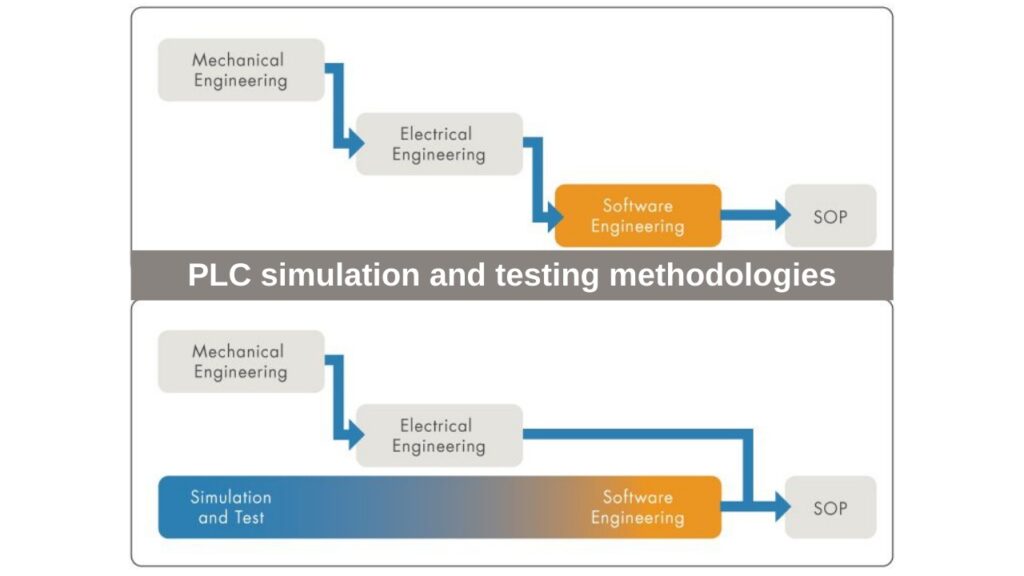PLC (Programmable Logic Controller) simulation and testing methodologies are essential in the development and maintenance of PLC systems.
1. PLC simulation:
PLC simulation is the process of creating a virtual environment that simulates the behavior of a PLC system. This can be used to test and validate the PLC program before implementing it on the actual system. PLC simulation enables engineers and technicians to identify and fix errors or bugs before deploying the program to the actual system.
The technique of simulating a real Programmable Logic Controller (PLC) system in a virtual environment is known as PLC simulation. Prior to deploying the PLC program to the actual system, the simulation can be used to test, validate, and troubleshoot the program.
Here are some key points related to these topics:
A virtual model of the Allen Bradley PLC system, including the inputs, outputs, and ladder logic program, is provided by PLC simulation software. Engineers and technicians can build a virtual world and test various scenarios using simulation software to verify the behavior of the program. It is possible to do this without running the danger of harming or upsetting the actual system.
Before the software is applied to the actual system, problems or bugs can be found and fixed using PLC simulation. As it lessens the need for physical testing and the chance of system outages, this can save time and money. Additionally, without requiring physical access to the actual system, PLC simulation can be used to instruct staff members on how to operate and maintain the PLC system.
The production of thorough reports and test results logs is another feature of PLC simulation software. This can be utilized for documentation needs and as a guide for maintenance and troubleshooting in the future.
Overall, PLC simulation is an important tool in the development and maintenance of PLC systems. Engineers and technicians should have a good understanding of PLC simulation software and its application to ensure the reliable and safe operation of PLC systems.
2. PLC testing:
PLC testing involves various methodologies to validate the PLC system’s functionality, reliability, and safety. Some of the common testing methodologies for PLC systems are:
Unit testing:
Testing individual program components to ensure they meet the requirements.
Integration testing:
Testing the integration of multiple components to ensure they work together as expected.
Acceptance testing:
Testing the system against the user’s requirements to ensure it meets their expectations.
Rockwell Automation PLC (Programmable Logic Controller) testing is the process of validating the functionality, reliability, and safety of a PLC system. PLC testing is essential in ensuring that the system operates as intended and meets the requirements of the application. There are different types of testing methodologies that can use to validate a PLC system.
Unit testing:
Unit testing involves testing individual components of the PLC program to ensure that they meet the requirements. This type of testing is often use during the development phase of the system.
Integration testing:
Integration testing involves testing the interaction of multiple components of the PLC program to ensure that they work together as intended. This type of testing is often use during the integration phase of the system.
System testing:
System testing involves testing the entire PLC system to validate its functionality, reliability, and safety. This type of testing is often use during the final phase of the system’s development.
Acceptance testing:
Acceptance testing involves testing the PLC system against the user’s requirements to ensure that it meets their expectations. This type of testing is often use to validate the system’s performance in real-world conditions.
1766-L32BXBA MicroLogix 1400 PLC testing can perform manually or automate using specialized testing software. Automated testing can be more efficient and reliable, as it can run continuously and provide detailed reports of the testing results.
In addition to testing the PLC program, it is also important to test the hardware components of the system, including sensors, actuators, and other peripherals. Hardware-in-the-loop (HIL) testing is a technique that involves testing the PLC system in a simulated environment using actual hardware components. This can use to validate the system’s performance and reliability under various operating conditions.
Overall, PLC testing is essential in ensuring the reliable and safe operation of PLC systems. Engineers and technicians should have a good understanding of the different testing methodologies and techniques to ensure that the PLC system meets the requirements of the application.
3. Hardware-in-the-loop (HIL) testing:
HIL testing involves testing the PLC system in a simulated environment using actual hardware components. This can use to validate the system’s performance and reliability under various operating conditions.
4. Continuous testing:
Continuous testing involves automating the testing process to run continuously during the PLC system’s development and maintenance. This can help identify issues early on and reduce the time and cost of fixing them.
Also read: Write My Case Study: Tips for Creating an Impactful Case Study
Overall, PLC simulation and testing methodologies are important in ensuring the reliable and safe operation of PLC systems. Engineers and technicians should have a good understanding of these methodologies and apply them throughout the PLC system’s development and maintenance lifecycle.

